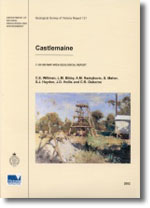GSV Report 121 - Castlemaine 1:100 000 map area geological report
 |
| |||||||||||||||||||||||||||||||||||||||||||||||||||||||||||||||||||||||
Product description:Download The downloadable version of this report is supplied in PDF format and is a large file (23.0MB). Abstract This report describes the geology, geophysics and mineral potential of the Castlemaine 1:100 000 map area (CASTLEMAINE) covered by the accompanying 1:50 000 geological and 1:100 000 geophysical maps. It provides a comprehensive account of the geological history, landscape evolution, rock units, geophysical character, geological structure and economic geology of the map area. The report also outlines the regional geological setting and provides a summary of previous geological work. Photographs, diagrams and tables complement the text and include a compilation of radiometric ages and a summary of previous mineral exploration. There is a comprehensive reference list and a detailed excursion guide, designed to show the major geological features of the area. The map area lies in the Bendigo Zone of the Whitelaw Terrane in the western Lachlan Fold Belt (VandenBerg et al., 2000). The oldest rocks are Palaeozoic deep marine turbidites of the Castlemaine Group. The Castlemaine Group forms most of the basement in CASTLEMAINE and consists largely of thick-bedded turbidites and mudstone with occasional black shale units that yield fossil graptolites. Devonian granites form the remainder of the basement. Regional deformation in the Late Ordovician – Early Silurian (Benambran Orogeny) strongly deformed the Palaeozoic sedimentary rocks. The rocks were folded into upright, tight chevron folds with an associated penetrative cleavage, cut by numerous steeply dipping reverse faults and were metamorphosed to greenschist facies. The Muckleford Fault is the largest fault in CASTLEMAINE. It has a strongly strained hanging wall and was active during regional deformation. The Taradale Fault may be the southern continuation of the Whitelaw Fault. The Tabberabberan Orogeny in the Middle Devonian mildly affected the basement rocks resulting in the development of a regional kink-fold and small strike-slip faults. In the Late Devonian, granitic plutons intruded the deformed Castlemaine Group. Basaltic and lamprophyre dykes of unknown age also occur in the Castlemaine Group and in Devonian granites. There is little evidence for significant tectonic activity after the Middle Devonian. Remnants of Permian glacial tillite lie scattered on the basement. Erosion intensified after Cretaceous uplift related to Gondwana break-up. Several cycles of Cainozoic erosion and voluminous outpourings of basalt strongly influenced the evolution of the present-day landscape. Two main periods of orogenic gold mineralisation have been identified in CASTLEMAINE. In both events gold was introduced into the basement rocks in structurally controlled quartz reefs. The first and most important event was associated with the late stages of the Benambran Orogeny. The second, minor, event is related to Middle Devonian mineralisation that affected only a few areas in the Bendigo Zone but was the most significant mineralising event in the Melbourne Zone. About 300 t of gold has been mined from both placer and quartz reef deposits. The most productive goldfields in CASTLEMAINE are at Castlemaine and Daylesford. Weathering and erosion has remobilised substantial amounts of gold into some of the Cainozoic units to form placer deposits that were extensively mined in the past. Nonmetallic resources include clay, sand, gravel and basalt. Groundwater aquifer systems are well developed in Cainozoic sub-basaltic gravels and mineral water is a significant resource in some parts of CASTLEMAINE. Cainozoic volcanics cover 20% of CASTLEMAINE. They form scoria cones, lava domes and lava plains and a new formation, the Lalgambook Breccia, has been recognised in a small area. Aerial photo interpretation combined with the interpretation of geophysical data shows that lava plains consist of several flows that show differences in the polarity of magnetisation. Bibliographic reference Willman, C.E., Bibby, L.M., Radojkovic, A.M., Maher, S., Haydon, S.J., Hollis, J.D. & Osborne, C.R., 2002. Castlemaine 1:100 000 map area geological report. Geological Survey of Victoria Report 121. Related products:
| ||||||||||||||||||||||||||||||||||||||||||||||||||||||||||||||||||||||||






